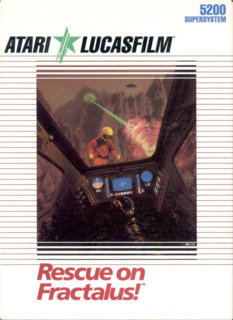Full of fractals goodness.
Graphics: 8
Sounds: 8
Value: 8
Tilt: 8
Note: This review is based on the Atari XL computers and not the Atari 5200. I used the Atari 5200 only because of the game's cover box.
George Lucas seems to have this ‘inner site’ when it comes to entertaining the public. It’s like he has this Midas touch where everything he delivers turns to gold (well almost anyway). Considering the extraordinary success of the Star Wars saga back in the late 70s and early 80s, Lucas branch his entertainment powers to the ever-so-young gaming market. This was a daring feat indeed as the time when his company ‘LucasArts’ was founded in 1982 the console market (mainly dominated by Atari) was heading south as poorly made computer games plagued the shelves.
Lucas, with the cooperation of Atari, released the company’s very first two games in 1985 being Ballblazer and Rescue on Fractalus. Both produced an innovative and unique approach to the fledging computer gaming market. The developers must of have this uncanny ability to produce such a wonderful and superior looking game using the very same technology that produced for example Defender!
The original premise for Rescue on Fractalus was a simple save the crashed fighter pilots and haul them up to safety to the mothership beyond the planet's atmosphere. You can say it’s a search and rescue type of game. There was no shooting as this was against the developer’s intension. When presented to George Lucas, George thought this game would be boring without blasting things hence the fire button was made. Now the premise turns out to save the shot down fighter pilots whilst being fire-upon from enemy Jaggies nested on mountain peaks whilst avoiding kamikaze UFOs.
And it doesn’t stop there!
The planet's atmosphere is acidry, the entire surface mountainous (hence hard to land) and the planet will turn from day to night hence heavy reliance on your ship’s equipment. Now imagine if George hasn’t made his input?
I found it hard to believe that the very same Atari XL computer fueled Rescue on Fractalus was the same that played Dig Dug! It was amazingly ground breaking. The first person view never looked better in any other game during its time and the concept of fighting in day and night was a dream come true. This made the game soo eerie as you cannot see the ground to land your ship therefore heavy reliance on your on-board computer system.
However and arguably the best part was the pilots themselves. You are required to land near the crashed ship (whilst the Jaggies are merrily shooting above), cut your shields and engines (so the Jaggies cannot lock on you and making it safe for the pilot to run towards your ship) and wait.
And wait, and wait and wait for that ‘tap, tap, tap’ on the hull of your ship to indicate ‘I’m here, let me in’. Open the cargo door, the pilot pops in and time to move on to grab your quota of saved pilots before boosting up to the heavens. And if you are lucky, an Ace fighter pilot will enter your ship for extra points and fuel.
I must admit this part has to be the first game for what I have played that made me felt uneasy.
Very uneasy.
Why was that, at times (especially at the higher levels) there will be absolutely no tapping on the hull, silence is all around you and afterwards that seems like eternity, at lightning fast pace an alien will burst into view with that haunting spine-chilling sound and if you are not quick enough to turn on your shields to fry it, it will punch through your windscreen – game over. Just like that. And believe me this happens so quick as you are trying to gather your senses of that terrifying reverberation and by the time you press that ‘s’ key, too late. And please do not open your cargo bay too early as if the alien does board your ship, it is ‘Goodbye Charlie’ to you. Now insert that night factor and you’ll have an adequate horror game.
As mentioned before, the technology that fueled this game was way ahead for its time. Instead of pre-rending the mountainous landscapes, the developers used fractals. This was a very clever way of creating distinctive landscapes that rarely duplicates. Hence when flying through the mountainous Fractalus, it’s like the saying ‘A stranger in a strange place’ hence that’s how Fractalus got its name. As a side note, this fractals technology also fuelled later LucasArts titles like Ballblazer (the musical scores), the landscapes of Koronis Rift and the caverns of The Eidolon.
Conversely, the original name for this game was called ‘Behind Jagged Lines’. Behind Jagged Lines became an in-house joke and a double-meaning for 1) You are fighting against the Jaggies and 2) the graphics depicting the cockpit of the spacecraft were not anti-aliased and are therefore very ‘jagged’.
Rescue on Fractalus was a game way ahead for its time. I’m not going to say it’s ‘game-of-the-year’ material as 1985 was a great year for gaming. You have Hacker, Star Raiders II, Phantasie, Bounty Bob Strikes Back and Alternate Reality – The City all broke that humdrum platform game genre. What made Rescue on Fractalus special and stands out from the crowd was using this Fractal technology places the player having each mission a unique-like experience and truly one of the first ‘horror-type’ theme that actually will scare players. I will admit that without this technology, the game will become stale very quickly so kudos will be given to George Lucas and the team for their excellent vision of generating ‘older’ technology into a modern marvel as it is.

